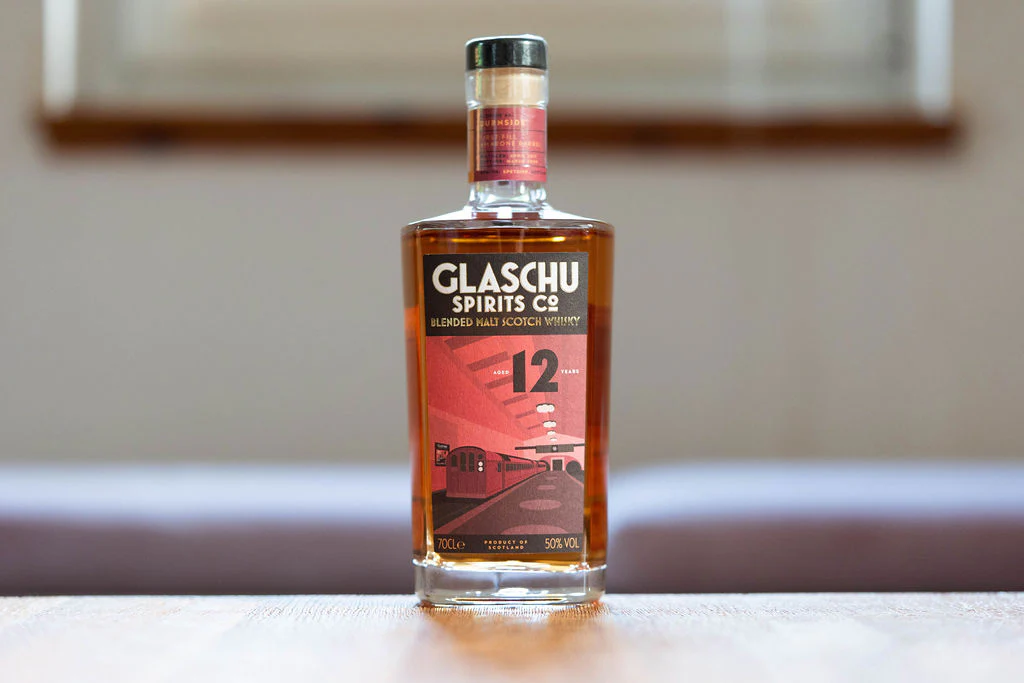
Glaschu and the Teaspoon - A Review
Finding time to write reviews is getting tougher and tougher as life in the shop combines with the ever growing and needy presence of a 15-month old boy.
Thankfully though, when the urge hits and a creative urge rises, there is no shortage of samples and bottles in the house that I can reach out and grab.
It has been a warm and muggy day, and on these particular days I typically enjoy something fruit forward, elegant and not too complex, so of those near at hand is a sample of one of our most recent additions to the shop - Glaschu.
The latest releases from Glaschu, the independent bottling arm of DamGood Drams, contains this lovely little Speysider, Burnside, at 12 years old and finished in an Amarone Red Wine Cask.
Burnside? A closed distillery? A new one? A secret producer for blends never to be seen as a single malt? Well, of the three options, this is perhaps the closest.
Burnside ‘contains’ whisky from two distilleries and is therefore regarded as a blended malt. I say ‘contains’, because there is always a little dubiety when it comes to this particular style of blending.
Burnside is a bottling name given to a teaspooned malt, said to contain liquid from two distilleries exceedingly close to both Balvenie Castle and the Fiddich Burn. Each cask under the Burnside name has been visited by a warehouseman-come-blender, carrying a bung hammer, a bucket filled with whisky from a (very) nearby distillery, and a teaspoon.
This blender opens each cask, tips a teaspoon of liquid into the cask, and seals it up again, marking the cask as a Burnside, and thus, creating single cask blends along the way. This is a practice used by many Single Malt Distilleries, bottled by Independent Bottlers under the monikers Wardhead, Dalrymple, Whitport, Williamson and Westport, amongst others.
Let’s say that the practice does take place, and the cynic in me suggests otherwise, the influence of a 6ml teaspoon of one whisky into a 250 litre cask of whisky equated, after 10 years, to 0.00004% of the total contents (maths courtesy of the Whisky Aardvark).
So what we can say is that what is now in my glass is 99.99996% Bourbon Cask whisky B*****ie, but with the addition of nearly two years of finishing in Amarone Cask and the addition of water to cut down to a bottling strength of 50% ABV.
This matters not, really, when it comes to the flavour. It’s merely a story of provenance and practice to allow you to understand what to expect from this dram, alluding to quality whisky making from the heart of Speyside.
For such a young bottler, Glaschu have made great strides in sourcing some of the lesser-available names in single casks, Glenglassaugh, Tomintoul and, now, Bal- er - Burnside.
The finish in Amarone wine was 18 months, so what do we expect? Amarone is fast becoming a big player in the Italian Wine scene, though it is hardly a new style. It is a fruit forward, rich wine created using a method known as appassimento. Naturally, the grapes are dried out prior to fermentation which results
So, how does this whisky hold up after such a big intro….
On the nose initially, is soft, very fruity and smells juicy. With jelly cherry sweets and strawberry laces dominating an almond biscuit base. It’s pleasant and ‘nice’, without being overly complex and interesting. There’s absolutely nothing to dislike here, and at 50% (Glaschu’s preferred bottling strength) it isn’t tainted by a spike of alcohol, making it perhaps more appealing to those who enjoy single cask whisky pre-cut.
In time, more spices to come through, with a more savory note appearing in the form of tannic spices and bittersweet raspberries.
The palate continues the red currant and fruits but more tannic and active than the sweetie shop nose. Black Cherries, blackcurrant jam, dark chocolate fruit and nut bar all appear on the top of the palate and initial sweetness. As the whisky goes down, some cereal notes come through. Hob Nob biscuits, and honey-covered oatmeal bars come through.
The finish is light, melting into the palate pleasantly but surprisingly, it lingers longer than I initially thought it would. Freshly baked mince-meat pies dusted in sugar comes to mind as a curveball note popping up right at the end.
A really enjoyable dram, and perfect at it’s bottling strength. At £69.00 a bottle it is on par with most 12 year old single casks, and given this is only a couple of pounds dearer than a core range equivalent 12 year old at 40%, it seems excellent value for money.




Leave a comment